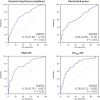Mechanical Power Density Predicts Prolonged Ventilation Following Double Lung Transplantation
- PMID: 37799668
- PMCID: PMC10548550
- DOI: 10.3389/ti.2023.11506
Mechanical Power Density Predicts Prolonged Ventilation Following Double Lung Transplantation
Abstract
Prolonged mechanical ventilation (PMV) after lung transplantation poses several risks, including higher tracheostomy rates and increased in-hospital mortality. Mechanical power (MP) of artificial ventilation unifies the ventilatory variables that determine gas exchange and may be related to allograft function following transplant, affecting ventilator weaning. We retrospectively analyzed consecutive double lung transplant recipients at a national transplant center, ventilated through endotracheal tubes upon ICU admission, excluding those receiving extracorporeal support. MP and derived indexes assessed up to 36 h after transplant were correlated with invasive ventilation duration using Spearman's coefficient, and we conducted receiver operating characteristic (ROC) curve analysis to evaluate the accuracy in predicting PMV (>72 h), expressed as area under the ROC curve (AUROC). PMV occurred in 82 (35%) out of 237 cases. MP was significantly correlated with invasive ventilation duration (Spearman's ρ = 0.252 [95% CI 0.129-0.369], p < 0.01), with power density (MP normalized to lung-thorax compliance) demonstrating the strongest correlation (ρ = 0.452 [0.345-0.548], p < 0.01) and enhancing PMV prediction (AUROC 0.78 [95% CI 0.72-0.83], p < 0.01) compared to MP (AUROC 0.66 [0.60-0.72], p < 0.01). Mechanical power density may help identify patients at risk for PMV after double lung transplantation.
Keywords: extubation; lung transplantation; mechanical power; prolonged ventilation; ventilator weaning.
Copyright © 2023 Ghiani, Kneidinger, Neurohr, Frank, Hinske, Schneider, Michel and Irlbeck.
Conflict of interest statement
The authors declare that the research was conducted in the absence of any commercial or financial relationships that could be construed as a potential conflict of interest.
Figures




References
-
- Snell GI, Yusen RD, Weill D, Strueber M, Garrity E, Reed A, et al. Report of the ISHLT Working Group on Primary Lung Graft Dysfunction, Part I: Definition and Grading – A 2016 Consensus Group Statement of the International Society for Heart and Lung Transplantation. J Heart Lung Transpl (2017) 36(10):1097–103. 10.1016/j.healun.2017.07.021 - DOI - PubMed
-
- Sage AT, Peel J, Valero J, Yeung JC, Mingyao L, Cypel M, et al. Time to Extubation for Lung Transplant Recipients Represents a Pragmatic Endpoint to Guide the Development of Prognostic Tests. J Heart Lung Transpl (2023) S1053-2498(23):01926–5. Online ahead of print. 10.1016/j.healun.2023.06.019 - DOI - PubMed
MeSH terms
LinkOut - more resources
Full Text Sources
Medical

